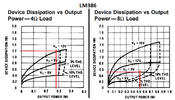The graph of p-p output voltage vs supply voltage and load shows that an LM386 amplifier has a low maximum output current. When bridged with an 8 ohms load, each LM386 is driving the same current as in a 4 ohm load. The high 12V supply in post #9 makes it worse.
Each LM386 has a p-p output of 10V with a 12V supply and a 16 ohms load but the output drops to only 3.5V with a 4 ohms load. The output into 4 ohms is the same when the supply is from 8V to 12V instead of normally increasing the p-p level by 50%.
The graph of output power and heating shows that each LM386 powered from 9V and driving an 8 ohm load produces an output of 0.52W and heats with 0.52W. But an LM386 powered from 12V and driving a 4 ohm load produces an output of only 0.28W and heats with 1.2W.
Each LM386 has a p-p output of 10V with a 12V supply and a 16 ohms load but the output drops to only 3.5V with a 4 ohms load. The output into 4 ohms is the same when the supply is from 8V to 12V instead of normally increasing the p-p level by 50%.
The graph of output power and heating shows that each LM386 powered from 9V and driving an 8 ohm load produces an output of 0.52W and heats with 0.52W. But an LM386 powered from 12V and driving a 4 ohm load produces an output of only 0.28W and heats with 1.2W.


